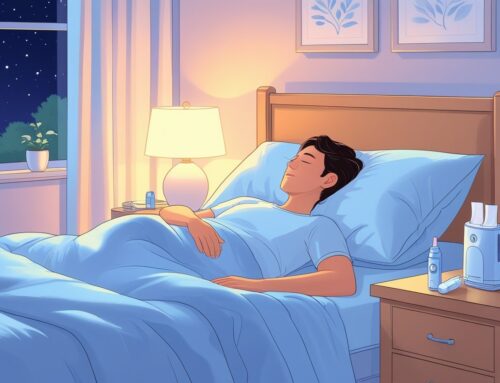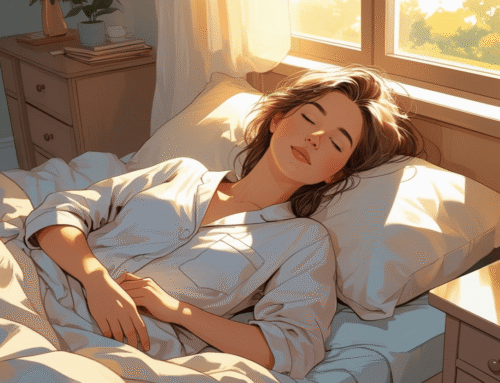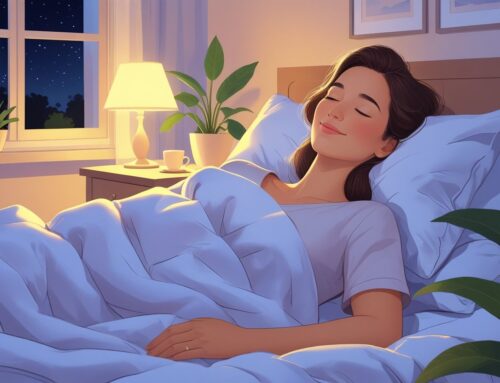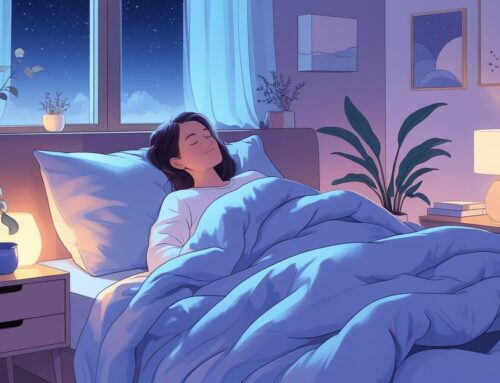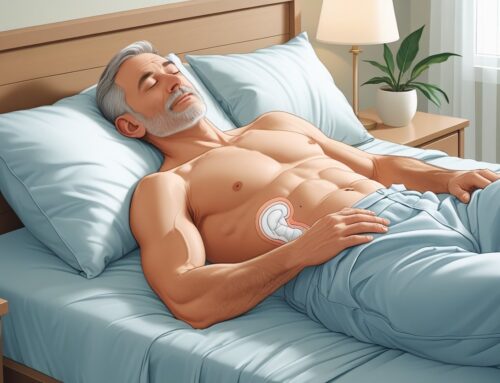Many adults find it hard to fall asleep at night. Stress, busy thoughts, and certain habits make it worse. Creating a calm space and using simple methods that relax both the mind and body can make it easier. Even small changes can shorten the time it takes to sleep and improve rest overall.
One of the most helpful steps is keeping a routine. Going to bed and waking up at the same time each day helps your body learn when it should rest. Avoiding screens like phones and TVs before bed also makes a big difference. Simple breathing methods, such as the 4-7-8 technique or progressive muscle relaxation, calm the body and prepare it for sleep.
Better sleep usually comes from the habits you build. Quick relaxation exercises, a steady bedtime routine, and a comfortable sleep setting make it easier for many people to drift off. Over time, these small steps also lead to better mornings with more energy and focus.
Key Takeaways
- A steady routine and calm activities help you fall asleep faster.
- Relaxation techniques, like deep breathing, prepare the body for rest.
- A quiet, comfortable environment supports good sleep.
- The right mattress helps adults fall asleep faster by giving proper support, easing pressure points, and keeping the body comfortable enough to relax quickly.
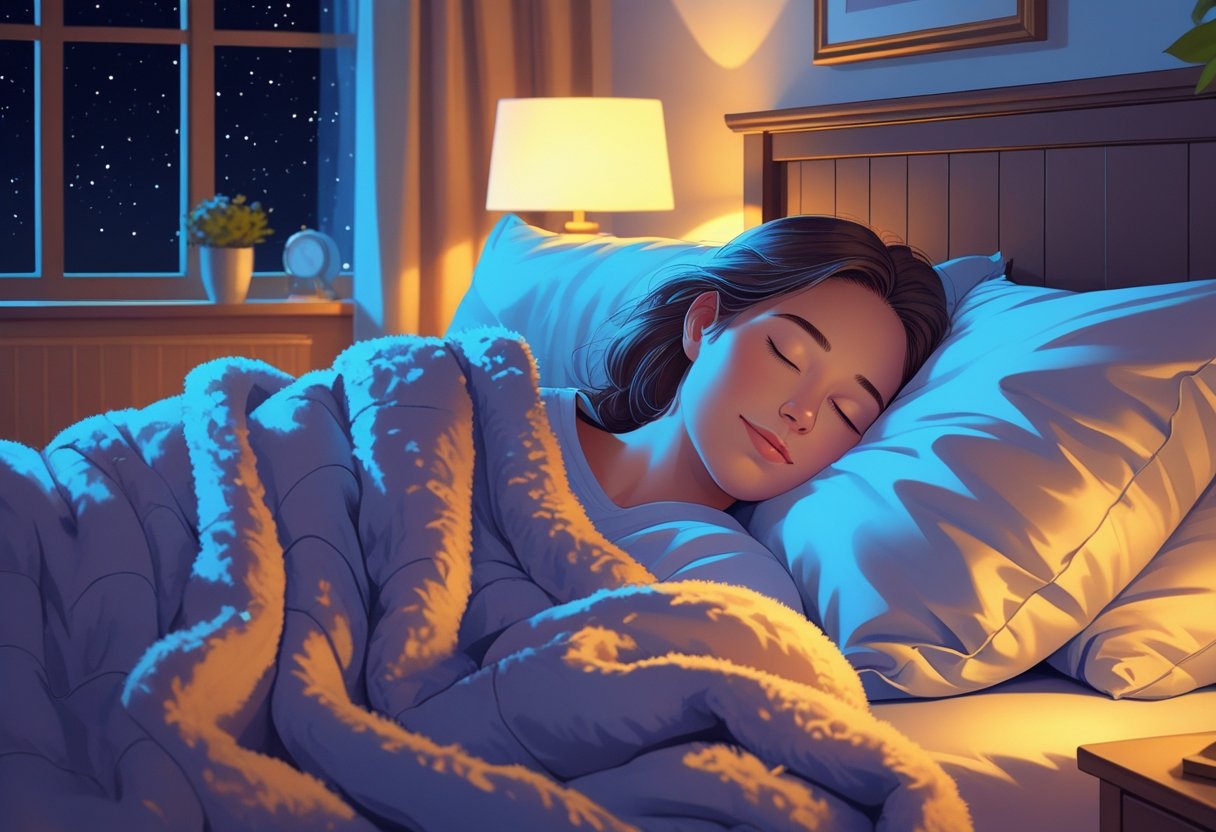
Understanding Why Adults Have Trouble Sleeping Fast
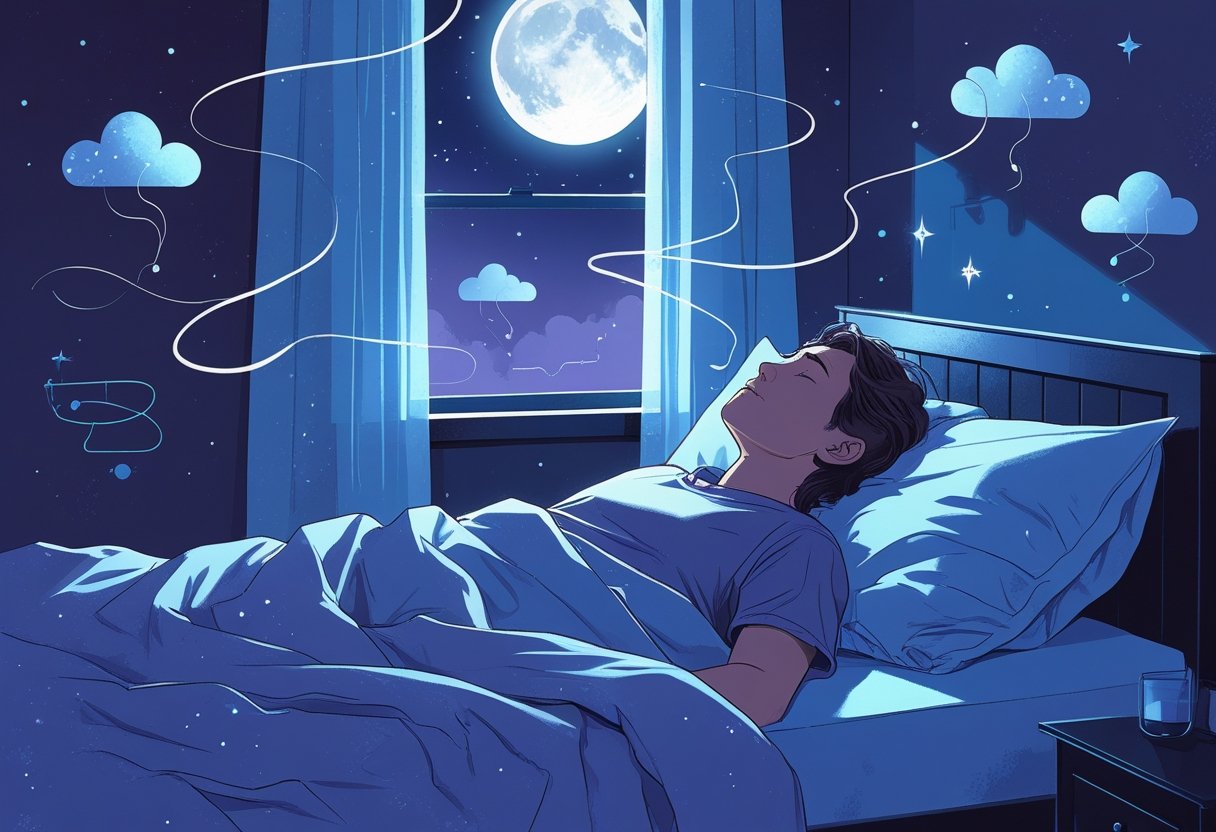
Many adults find it hard to fall asleep quickly due to a mix of physical and mental factors. These include daily stress, changes in the body’s internal clock, and health problems. Understanding what causes these issues can help them address the root problems.
Common Barriers to Quick Sleep Onset
For a lot of people, the hardest part of bedtime is shutting off their thoughts. Stress about work, family, or what tomorrow might bring can keep the brain active long after lying down. And screens don’t help like scrolling through a phone or watching TV tricks the brain into thinking it’s still daytime, which slows down the natural process of falling asleep.
Habits play a role too. Drinking coffee or alcohol late at night can throw off sleep. A room that feels too warm, a lumpy mattress, or background noise makes it harder to relax. On top of that, health issues like body aches or restless legs keep many people tossing and turning. All of these small factors can add up, making it take much longer to drift off.
Effects of Sleep Deprivation on Health
Not getting enough sleep shows up in the body quickly. The immune system weakens, making it easier to catch colds and other illnesses. Over time, missing out on rest can increase the risk of more serious health problems, including heart disease, high blood pressure, and diabetes.
The mind feels the strain just as much. Without good sleep, it’s easy to feel irritable, distracted, or overwhelmed. Memory slips and mood swings become more common. And once poor sleep sets in, the stress it causes can make it even harder to sleep the next night. It becomes a loop that’s tough to break.
The Sleep-Wake Cycle and Circadian Rhythm
Sleep is guided by the body’s internal clock, known as the circadian rhythm. This system tells the body when it’s time to be alert and when it’s time to rest. But late nights, shift work, or jet lag can throw that rhythm off, making sleep feel out of reach.
Light is the main signal that keeps the cycle steady. Daylight helps the body stay awake, while darkness encourages the release of melatonin, the hormone that brings on sleep. When that balance gets disrupted, sleep often feels shallow or delayed. Keeping a steady routine and paying attention to light exposure can help reset the rhythm and make falling asleep feel natural again.
Essential Pre-Sleep Habits for Falling Asleep Faster
Getting ready for bed doesn’t just mean turning off the lights. The way you spend your evenings can make it easier to fall asleep and stay asleep. Keeping a regular bedtime, having a calm routine, and being mindful of daily habits all play a part in better rest.
Establishing a Consistent Sleep Schedule
Going to bed and waking up at the same time every day helps your body know when it’s time to rest. This consistency supports melatonin, the hormone that signals sleep. When you shift your schedule too much, like sleeping in on weekends, it can throw your body off and make falling asleep harder. A set bedtime and alarm make sleep more predictable. Over time, your body adjusts and starts preparing on its own. This can cut down the time it takes to drift off.
The Role of a Wind-Down Routine
The brain needs signals to slow down before sleep. Simple activities like reading, stretching lightly, or listening to calm music can send the message that it’s time to rest. Screens, however, do the opposite. The light from phones or laptops makes it harder to feel sleepy, so it’s best to avoid them an hour before bed.
Even small habits, like washing your face, brushing your teeth, and dimming the lights, help create a rhythm. Doing them in the same order each night makes your brain connect those steps with bedtime.
Optimizing Daily Habits for Better Sleep
What you do during the day also affects your sleep at night. Caffeine, nicotine, and alcohol can make it harder to rest, especially if you have them late in the day. Exercise supports good sleep, but intense workouts too close to bedtime may keep you wired. Naps can be refreshing, but they work best when they’re short and earlier in the day. Stress is another factor, if you don’t manage it, it often shows up at night. Relaxation techniques during the day can help calm the mind before bed.
And one last simple habit: don’t drink too much water right before sleep. Waking up for bathroom trips can break your rest. With small adjustments like these, you set yourself up for deeper, more consistent sleep.
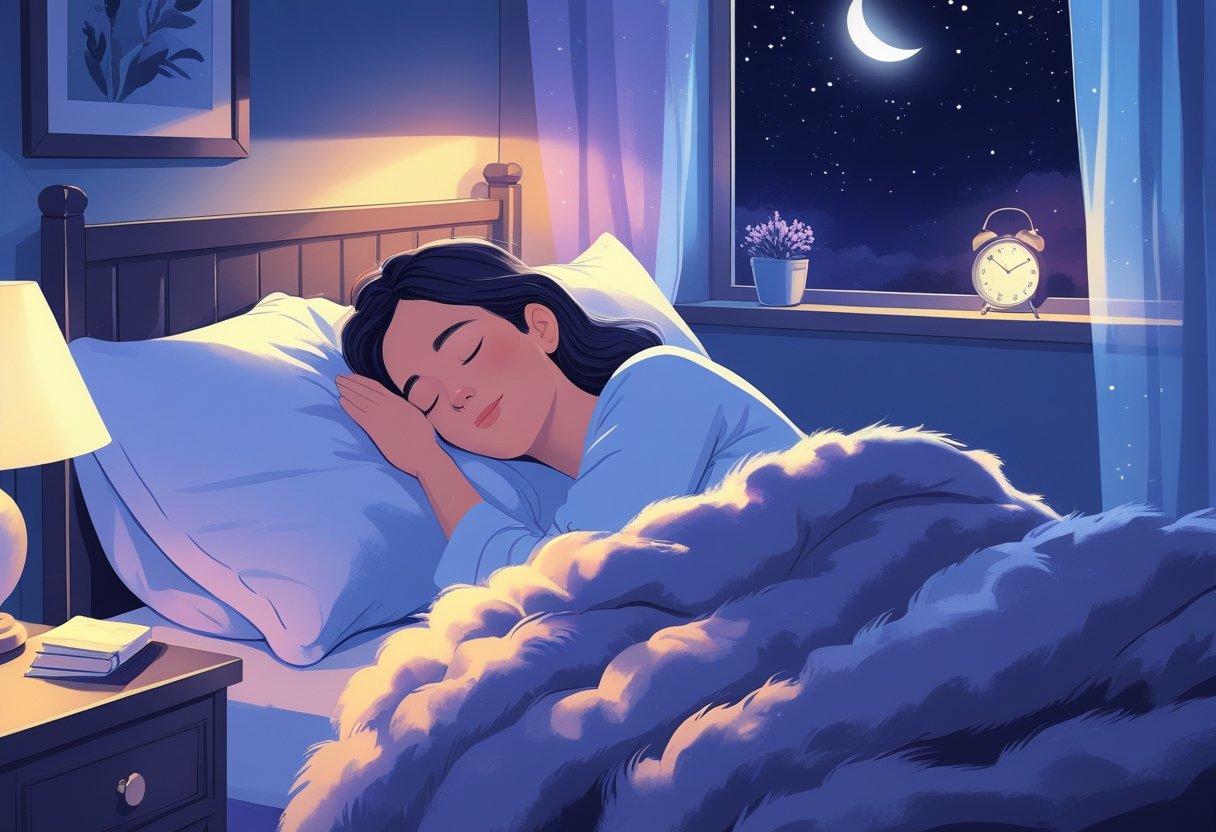
Creating the Ideal Bedroom Environment
A bedroom set up correctly helps a person fall asleep fast and stay asleep longer. It involves controlling temperature and light, reducing noise, and picking bedding that supports comfort and rest.
Temperature and Light Optimization
A cool room makes it easier to fall asleep. Around 65°F (18°C) is often recommended. Cooler air helps the body relax and signals it’s time to rest. If that feels too cold, it’s better to add or remove blankets instead of changing the thermostat. Light also matters. Bright light or blue light from phones and TVs can confuse the body and delay sleep.
Keeping lights dim in the evening and using blackout curtains can help. Warm, soft light works better than bright bulbs. Turning off screens at least half an hour before bed gives the brain a chance to slow down.
Managing Bedroom Noise
Noise can easily disturb sleep. A quiet space helps you fall asleep faster and stay in deep sleep longer. Sudden sounds or ongoing noise often lead to waking up through the night. There are simple ways to manage this. White noise machines or a fan can cover outside sounds. Noise-blocking curtains and window seals also make a difference. It’s also best to keep buzzing or beeping electronics out of the bedroom. Some people find that soft background sounds, like rain or calm music, help them relax. The main goal is to avoid loud or disruptive noise that interrupts rest.
Choosing the Right Bedding and Sleep Accessories
The right mattress and bedding affect how well you sleep. A mattress should match your body and sleeping style. Softer memory foam can support curves, while firmer options keep the spine in line. Pillows also matter. They shouldn’t be too high or too flat, because that strains the neck. Sheets and blankets made from cotton or bamboo help regulate body temperature by staying cool and breathable.
Clean bedding also helps. Washing sheets and pillowcases often reduces allergens that cause irritation or restless nights. Some people also use calming scents like lavender to create a relaxing space. A clean, comfortable bed setup signals the body that it’s time to rest.

Quick Techniques to Sleep Fast
Falling asleep isn’t always easy, especially when your mind won’t stop running. Simple methods that you can repeat every night make a difference. These techniques help slow stress, ease tension, and show the body it’s time to rest. By focusing on breathing, relaxing muscles, and quieting thoughts, you can fall asleep faster and more naturally.
The Military Method for Instant Sleep
The Military Method was created to help people fall asleep in less than two minutes. It works by relaxing the body step by step while keeping the mind calm. It starts with the face, releasing tension in the jaw, tongue, and muscles around the eyes. Then, the shoulders and arms are dropped, one side at a time, letting everything feel heavy. After that, the focus moves to the chest and breathing, followed by loosening the legs from thighs down to calves.
The last step is clearing the mind. If random thoughts pop up, you imagine calming scenes like lying in a canoe or being in a dark, quiet room. Practicing this routine often teaches the body a clear way to rest and makes falling asleep much easier.
Breathing Exercises: The 4-7-8 Technique
The 4-7-8 technique is a breathing pattern that slows the heart rate and encourages relaxation. First, you breathe in through your nose for 4 seconds. Then, you hold that breath for 7 seconds. Holding it allows oxygen to move deeper into the body, which tells the nervous system to settle down. Finally, you breathe out slowly through the mouth for 8 seconds. This step clears carbon dioxide and creates a calm, steady rhythm. Doing this 3 to 4 times in a row helps stop racing thoughts and gives the body a signal that it’s time to sleep.
Progressive Muscle Relaxation
Progressive Muscle Relaxation, or PMR, is about tightening and releasing muscles in order to let go of built-up tension. You begin at the feet, tensing the muscles for 5 to 10 seconds, then fully relaxing them for 20 to 30 seconds before moving to the next area. This continues up the body, legs, stomach, arms, and face, until every part feels loose. The process helps you notice where stress is stored and physically release it.
PMR works even better when paired with slow breathing. Together, they quiet the mind and relax the body, making it much easier to fall asleep quickly.

Mental Strategies and Cognitive Tools
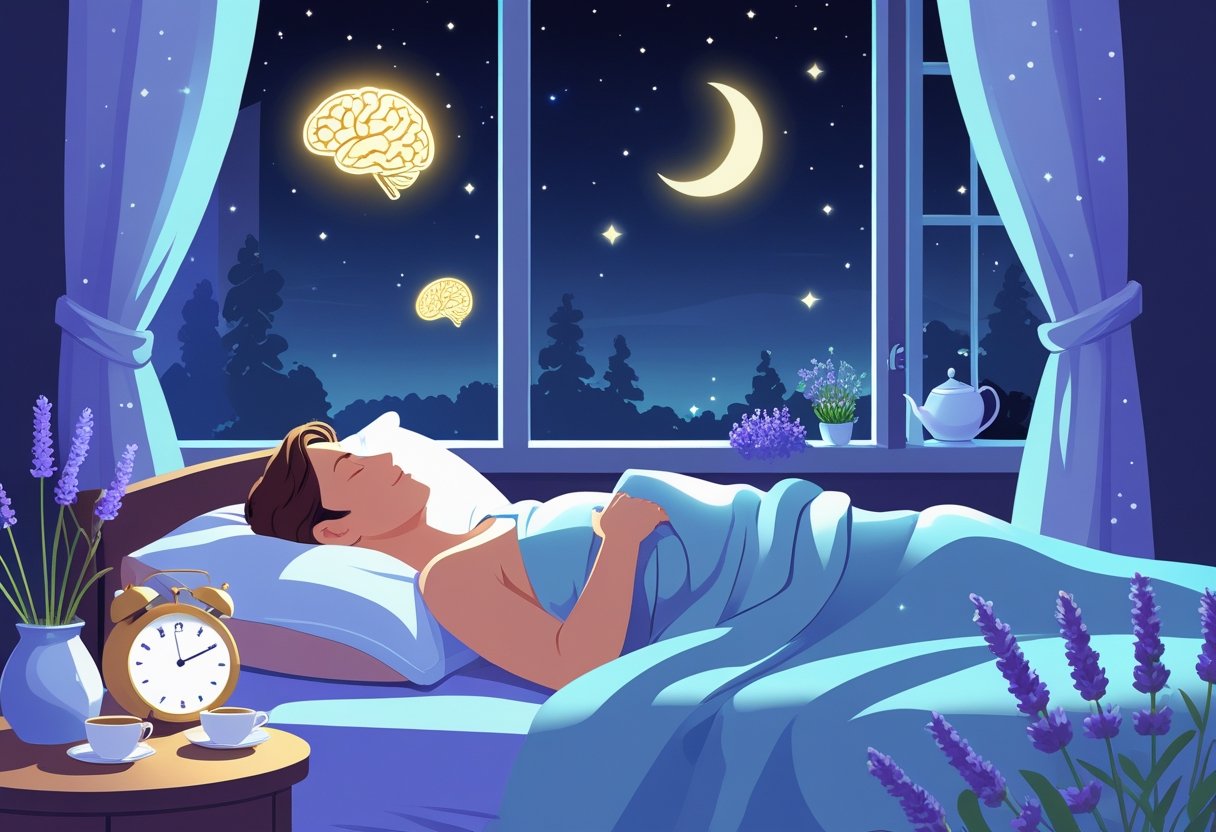
Sometimes the hardest part of sleeping isn’t your body—it’s your mind. When thoughts keep spinning, it’s tough to relax. Simple techniques that shift focus or reduce worry can make it easier to go from being awake to drifting off. The goal is to quiet the brain and create a calmer space before bed.
Visualization and Guided Imagery
One way to settle the mind is to picture calming scenes. This can be something simple, like walking along a quiet beach, or watching soft snow fall outside a window. Paying attention to details—the sound of the waves, the feel of cold air, the way light hits the water—helps keep stressful thoughts from taking over.
Guided imagery takes this a step further. Instead of just a quick picture, you follow a slow mental story, almost like someone is narrating a peaceful setting for you. It’s a way of replacing worries with neutral, restful images. Repeating this often slows down racing thoughts, making sleep feel less forced and more natural.
Paradoxical Intention: Telling Yourself to Stay Awake
It sounds strange, but sometimes the best way to fall asleep is to stop trying. With paradoxical intention, you do the opposite—you tell yourself to stay awake. This lowers the pressure that comes from thinking, “I have to sleep right now.” That pressure often makes insomnia worse.
By removing the stress of trying, your brain relaxes. You simply lie down, get comfortable, and say you’ll resist sleep as long as possible. Usually, the body takes over and sleep arrives on its own. It works because it breaks the cycle of worry about not sleeping.
Journaling and To-Do Lists to Clear Your Mind
A busy mind often keeps people awake. Writing down thoughts before bed can help. A quick to-do list or a short journal entry is enough to get things out of your head and onto paper. This frees the brain from repeating the same worries or reminders over and over. You don’t need to write a lot, five to ten minutes is enough. Keep a notebook close to your bed and jot down what’s bothering you or what you need to do tomorrow. With fewer thoughts crowding your head, it’s easier to relax and fall asleep.
Lifestyle Factors That Enhance Sleep Speed
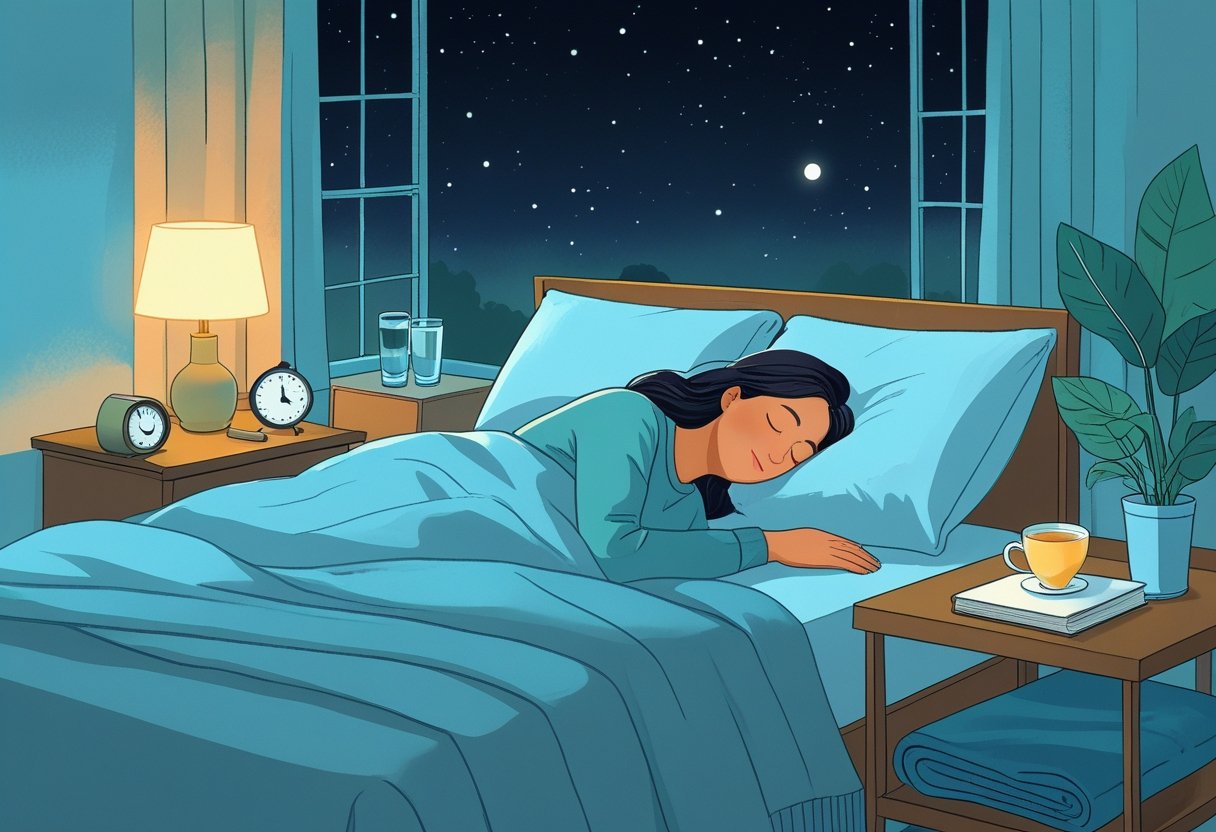
The way you move during the day, the food and drinks you choose, and how you use your phone or laptop all play a role in how quickly you fall asleep. Small changes in these areas can train your body to relax at night and make rest come easier.
Physical Activity and Exercise Timing
Being active helps the body feel ready for rest later. Exercise raises your body temperature, and when it cools down afterward, it signals the brain that it’s time to sleep. This is one reason why regular activity often leads to better nights of rest.
But timing matters. A tough workout too close to bedtime can keep you wired and delay sleep. Most experts suggest finishing exercise at least three hours before going to bed. Morning or afternoon workouts work best, but light movements like stretching or walking in the evening can calm you. Even 20 minutes of daily activity can make it easier to drift off.
The Impact of Diet and Caffeine
Food and drinks affect sleep more than people realize. Heavy or spicy meals right before bed often cause discomfort, which makes it harder to settle down. Eating dinner two to three hours before lying down is usually better.
Caffeine is another big factor. Coffee, tea, and soda can block the signals that make you feel sleepy. Cutting them off after 2 p.m. helps your body slow down naturally. Alcohol can trick you into thinking it helps with sleep, but it often interrupts deep rest later. If you’re hungry at night, stick with something light instead of a full meal.
Managing Screen Time and Blue Light Exposure
Phones, tablets, and laptops are one of the main reasons people struggle to fall asleep. These devices give off blue light, which tricks the brain into staying alert by lowering melatonin, the hormone that makes you tired. The easiest fix is to put screens away at least an hour before bedtime. Filters can help, but they’re not enough. Reading a book, listening to calm music, or practicing relaxation works better. Creating a routine without screens signals to your body that it’s time to rest.
Keeping a steady sleep schedule and making your bedroom dark and quiet also helps. When these habits, such as exercise, mindful eating, and less screen time, come together, falling asleep often becomes easier, sometimes in just a few minutes.
Natural Remedies and Advanced Techniques
Taking a warm bath or shower about an hour and a half before bed can help your body prepare for sleep. The heat raises your body temperature, and once you step out, your body starts to cool down. That drop in temperature signals to your brain that it’s time to rest. A warm soak also relaxes tight muscles and eases stress. Just keep the water comfortable, not too hot, around 104°F (40°C) is enough. Staying in for 15 to 30 minutes usually works well. It’s a simple routine that helps you feel calm and makes it easier to fall asleep.
Listening to Relaxing Sounds or White Noise
The sounds around you affect how well you sleep. Gentle background noise like rainfall, ocean waves, or steady white noise can block out distractions and make your environment feel more peaceful. This is especially useful if you live in a noisy place or if your mind tends to stay busy at night. You don’t need anything fancy. A small white noise machine or even a free phone app can do the job. Some people prefer nature sounds or quiet music. The key is to keep the volume low so the sound feels soothing, not distracting. Having a steady background noise can help you drift off without interruptions.
Acupressure and Other Alternative Approaches
Acupressure is another way people wind down before bed. Pressing certain spots, like the inside of your wrist or the space between your eyebrows, may help you feel more relaxed. It gives your body a gentle signal that it’s time to slow down. Adding deep breathing or light visualization while using acupressure can help even more. Others turn to gentle bedtime yoga or guided meditation to ease tension. These small steps quiet the mind and help the body settle into sleep.
Together, warm baths, calming sounds, and acupressure are natural ways to improve sleep without depending on medication. They’re simple habits that make nighttime rest easier to reach.
Mattresses and Falling Asleep Faster

A mattress affects how fast you fall asleep. If it feels stiff or doesn’t support your body, you’ll likely toss and turn instead of relaxing. The right one makes your body feel settled, which helps your mind calm down too. What feels comfortable depends on how you sleep. People who sleep on their side usually like something softer to ease pressure on the shoulders and hips. Back sleepers often need a firmer surface to keep their spine straight.
Here are the main things that matter in a mattress:
- Support: Keeps your spine in a healthy position
- Comfort: Reduces pressure in spots like shoulders and hips
- Temperature: Materials that breathe so you don’t get too warm
Hybrid mattresses mold to your body and limit movement, which can make sleep more restful. Taking care of your mattress, like rotating it now and then, also keeps it from sagging. When a mattress gets old, it often leads to restless nights. It’s important to find one that matches your body and habits. Leesa Sapira Hybrid Mattress, give you both foam comfort and coil support, so they work for naps or full nights of rest.
The Leesa Sapira Hybrid Mattress also has cooling features that stop heat from building up, which helps you sleep through the night. Its strong build keeps support steady over time, and the reinforced edges mean you won’t feel unstable whether you’re in the middle or near the side.
Frequently Asked Questions
Falling asleep faster usually comes down to habits and environment. Small changes in breathing, body position, diet, and bedtime routine can make it easier to relax and drift off.

